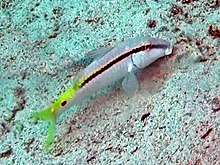Parupeneus forsskali
Parupeneus forsskali, common name Red Sea goatfish, is a species of goatfish belonging to the family Mullidae.
| Parupeneus forsskali | |
|---|---|
 | |
| Parupeneus forsskali from Sudan Coast | |
| Scientific classification | |
| Kingdom: | Animalia |
| Phylum: | Chordata |
| Class: | Actinopterygii |
| Order: | Perciformes |
| Family: | Mullidae |
| Genus: | Parupeneus |
| Species: | P. forsskali |
| Binomial name | |
| Parupeneus forsskali (Fourmanoir & Guézé, 1976) | |
| Synonyms[1] | |
| |
Etymology
The species name forsskali honors the Swedish naturalist and explorer Peter Forsskål (1732-1763).[2] Forsskål originally described this fish as Mullus auriflamma but the International Commission on Zoological Nomenclature suppressed this name in its decision number 846[3] and in 1976 Fourmanoir & Guézé proposed the name Pseudupeneus forsskali.[4]
Distribution and habitat
This species can be found in the Indian Ocean, from the Red Sea into the Gulf of Aden and in Socotra. Through the Suez Canal it is established in the eastern Mediterranean.[5] These marine subtropical fishes are shallow sandy bottoms and reef-associated, with a depth range 1–45 metres (3 ft 3 in–147 ft 8 in).[1]
Description
Parupeneus forsskali can reach a common length of about 25 centimetres (9.8 in), with a maximum length of 28 centimetres (11 in) in males.[1] The Red Sea goatfish has a relatively elongate body and a pointed snout, with the twin chin barbels typical of goatfishes. These fishes have eight dorsal spines, nine dorsal soft rays and seven anal soft rays. The body color is white with a broad black to dark brown stripe, sometimes tending to reddish, reaching from the upper lip through the eye and along the body, followed by an irregular roundish black spot at the base of the yellow caudal peduncle. Body above stripe is grayish green. The caudal fin is yellow, while the second dorsal and anal fins have narrow blue and yellow stripes.[1][6]
Biology
Red Sea goatfish spend most of their time moving slowly in small groups over the bottom searching for prey with their barbels. They mainly feed on small invertebrates living on sand bottoms (worms, small crustaceans).[1]
Bibliography
- Fenner, Robert M.: The Conscientious Marine Aquarist. Neptune City, USA : T.F.H. Publications, 2001.
- Helfman, G., B. Collette y D. Facey: The diversity of fishes. Blackwell Science, Malden, Massachusetts, USA 1997.
- Hoese, D.F. 1986: . A M.M. Smith y P.C. Heemstra (eds.) Smiths' sea fishes. Springer-Verlag, Berlin
- Manal M. Sabrah - Fisheries biology of the Red Sea goatfish Parupeneus forsskali (Fourmanoir & Guézé, 1976) from the northern Red Sea, Hurghada, Egypt - The Egyptian Journal of Aquatic Research - Volume 41, Issue 1, 2015, Pages 111–117
- Maugé, L.A. 1986. A J. Daget, J.-P. Gosse y D.F.E. Thys van den Audenaerde (eds.) Check-list of the freshwater fishes of Africa (CLOFFA). ISNB Bruxelles.
- Moyle, P. y J. Cech.: Fishes: An Introduction to Ichthyology, 4th. Ed., Upper Saddle River, USA - Prentice-Hall. 2000.
- Nelson, J.: Fishes of the World, 3rd. ed. USA: John Wiley and Sons.1994.
- Randall, J.E. (2004) Revision of the goatfish genus Parupeneus (Perciformes: Mullidae), with descriptions of two new species., Indo-Pacific Fishes (36):64 p
- Steven Weinberg - Découvrir la mer Rouge et l'océan Indien (2005)
- Wheeler, A.: The World Encyclopedia of Fishes, 2nd. Ed, London: Macdonald. Año
References
- Froese, Rainer and Pauly, Daniel, eds. (2019). "Parupeneus forsskali" in FishBase. December 2019 version.
- Christopher Scharpf & Kenneth J. Lazara (2 January 2020). "Order SYNGNATHIFORMES: Families DACTYLOPTERIDAE, PEGASIDAE, CALLIONYMIDAE, DRACONETTIDAE and MULLIDAE". The ETYFish Project Fish Name Etymology Database. Christopher Scharpf and Kenneth J. Lazara. Retrieved 9 April 2020.
- International Commission on Zoological Nomenclature (1968). "Opinion 846". Bulletin of Zoological Nomenclature. 25: 14–15.
- Pierre Fourmanoir; Paul Guézé (1976). "Pseudupeneus forsskali nom. nov. (= Mullus auriflamma Forsskål 1775)". Travaux et Documents de l'O.R.S.T.O.M. 47: 45–48.
- Niki Chartosia & ikolas Michailidis (2016). "First confirmed presence of the Red Sea goatfish Parupeneus forsskali (Fourmanoir & Guézé, 1976) from Cyprus". Marine Biodiversirty Records. 9 (33). doi:10.1186/s41200-016-0032-7.
- CIESM
External links
- Photos of Parupeneus forsskali on Sealife Collection